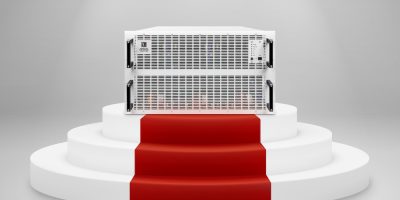EA Elektro-Automatik makes a power density breakthrough with its industrial series power supplies and loads
EA Elektro-Automatik, a manufacturer of DC power supplies for R&D and manufacturing, has introduced its 60kW and 3kW, EA-PU 10000 programmable DC power supplies, EA-PUB 10000 programmable bidirectional DC power supplies and EA-PUL DC programmable regenerative electronic loads.
Typical applications include electric vehicle battery pack testing, powering furnaces in semiconductor wafer fabrication facilities, electrochemical electrolysis processing and solar inverter testing. The new products, without manual front panel displays, are intended for use in production ATE systems and automated process control systems requiring high power.
The 60kW models output maximum voltages of 360.0V to 2000.0V and maximum currents of 480A to 80A; the 30kW models output maximum voltages of 60.0V to 2000.0V and maximum currents of 1000A to 40A. The 60kW series includes 21 models and the 30kW series consists of 29 models. The increased power capability allows engineers to reduce the number of power instruments needed for a high-power system, saving rack space and providing more power in a smaller footprint, claimed EA.
With 60kW in one 6U enclosure and 30kW in a 4U enclosure, EA Elektro-Automatik claimed to offer the highest power density available. Markus Schyboll, CEO of EA Elektro-Automatik, said that with the new 60kW and 30kW industrial series instruments, EA Elektro-Automatik provides space-saving, cost-effective solutions with priority on both safety and the lowest cost of ownership. He added that all its models have overcurrent, overvoltage, overpower, and overtemperature protection functions, and its new bidirectional power supplies and regenerative electronic loads have power factors of 0.99 and return up to 96% of absorbed power back to the grid.
Test engineers can parallel up to 64 of the 10000 series power supplies and loads using the Master and Auxiliary bus (formerly known as Master-Slave-Bus) to enable one instrument to control all instruments in the system, which can be paralleled up to 3.8MW. The system can consist of any combination of instrument models within the EA 10000 series family. A galvanically isolated Share-Bus interface in each instrument ensures that all the instruments safely share the load requirements so that no instruments in the system are overloaded.
A capacity of 60kW in one enclosure enables engineers to reduce the number of power instruments needed for a high-power system. This is claimed to save both substantial capital costs and critical rack space. In addition, the elimination of a front panel display further saves capital equipment costs.
All 10000 series instruments operate on the same firmware and have similar input and output characteristics. The common programming and user interface saves test development and setup time when building test and control systems requiring multiple power instrumentation.
All 10000 series instruments employ an autoranging output (input if an electronic load) characteristic. Autoranging enables the instrument to have a higher voltage capacity at lower currents and a higher current capacity at lower voltages than a power supply or load with a conventional rectangular output/input. An instrument with autoranging output/input can deliver/accept full power output over a significant portion of the instrument’s operating range. This is in contrast with an instrument with a rectangular output characteristic that has maximum power only at its maximum voltage and current. Unlike competitive units that offer an autoranging feature, EA claimed the benefit of its true autoranging capability for a test engineer is access to a wider range of voltages and currents, enabling the engineer to test more devices without the need for more instruments.
The EA-PU power supplies, EA-PUB bidirectional power supplies and EA-PUL electronic loads are available with an on-board full function generator (software option) to create signals riding on a DC bias and stimulate the characteristics of various devices such as solar cells, batteries and fuel cells. Special functions enable maximum power point tracking (MPPT) and EN 50530 solar panel inverter testing, and LV123-, LV124-, and LV148-standard based test sequences for testing of automotive components and systems. EA claimed an optional function generator simplifies the task of simulating various devices and creating sequences of outputs (or inputs) to comply with key test standards by eliminating the need for external waveform generation instrumentation to safely interconnect with an EA Elektro-Automatik instrument.
The 10000 series instruments work in either PC-controlled test systems or PLC-controlled industrial processes. Engineers can programme the instruments using SCPI or ModBus programming modes. The 10000 series instruments have galvanically isolated interfaces. Standard interfaces include Ethernet, USB and analogue, while optional interfaces include CAN, CANopen, RS-232, Profibus, ModBus, Profinet and EtherCat.




